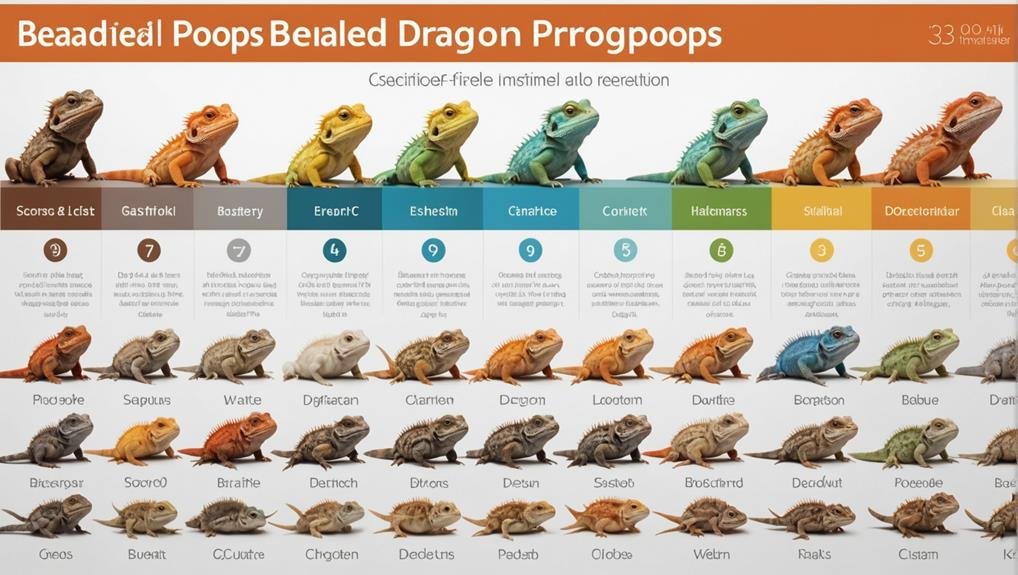If you own a bearded dragon, understanding their poop chart is essential for maintaining their health. By familiarizing yourself with normal and abnormal stool, you can spot potential issues early on. Healthy poop usually consists of brown fecal matter and white urates, but variations can indicate dietary problems or illnesses. Have you ever wondered how often your dragon should poop or what it means if their stool is an unusual color? These details can provide essential insights into their well-being, and knowing them might save you from unexpected vet visits.
Key Takeaways
- Healthy bearded dragon poop is brown and log-shaped with white, soft urates.
- Red poop indicates blood and may require veterinary attention.
- Yellow poop can signal dehydration or liver issues, suggesting diet adjustment.
- Green poop could result from certain greens or indicate parasitic infection if persistent.
- Runny poop signifies dietary changes or infections; monitor and adjust the diet accordingly.
How Often Bearded Dragons Poop
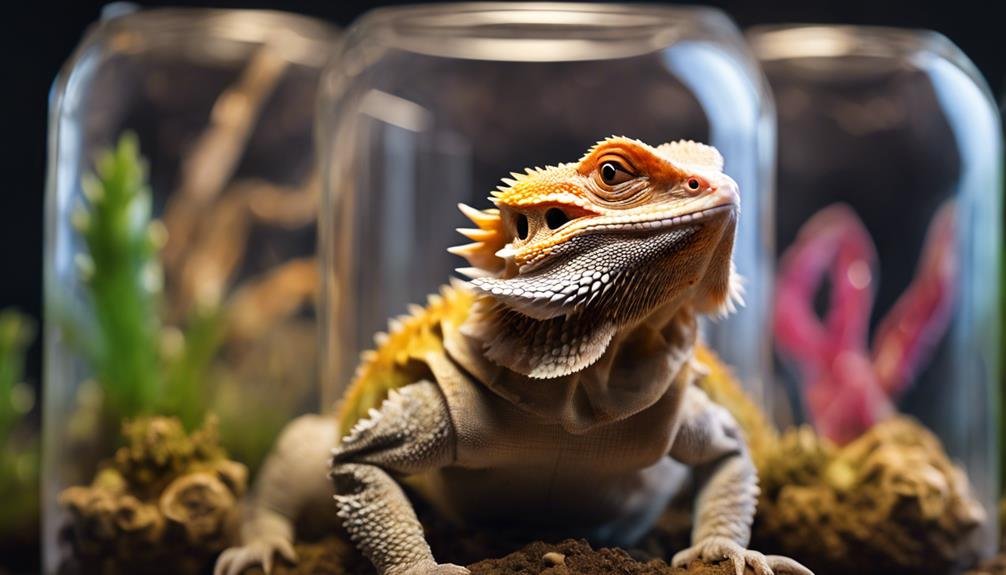

Bearded dragons usually poop every 1-2 days, though this can vary based on their age and diet. Younger dragons tend to have more frequent bowel movements than adults. If you have a juvenile bearded dragon, you might notice they poop almost daily. This high frequency is important due to their rapid growth and metabolism.
Diet plays a significant role in how often your bearded dragon poops. A diet rich in protein, like feeder insects, can lead to more frequent pooping, while a diet higher in vegetables might slow things down a bit. It would be best to aim for a balanced diet to keep your dragon healthy and its digestive system running smoothly.
Changes in activity levels can also affect how often your bearded dragon’s poop. Inactivity or stress can decrease the frequency of bowel movements. If your dragon is less active or seems stressed, you might notice they’re not pooping as often.
Monitoring your dragon’s poop frequency is important for evaluating their health. If you notice any drastic changes, it could be a sign of an underlying issue. Keeping a close eye on their pooping habits will help you make sure your bearded dragon stays happy and healthy.
Bearded Dragons and Urination
Let’s talk about how bearded dragons handle urination. Instead of liquid urine, they produce a substance called urates, which can tell much about their hydration levels and overall health.
Urate Composition Explanation
Understanding the composition of urates in your bearded dragon’s poop is essential for monitoring their health. The urate is the white part of the poop, composed of uric acid crystals. By examining the urate composition, you can gain insights into your dragon’s hydration levels and dietary balance.
Bearded dragons excrete urates along with their bowel movements, and the appearance of these urates provides valuable clues. For instance, if the rates are chalky and hard, it might indicate that your dragon has excess calcium in their diet. On the other hand, consistently soft or runny urates could suggest other dietary imbalances or potential health issues.
Regularly checking the urate composition can help you make informed decisions about your dragon’s diet and overall care. It’s a straightforward way to assess whether they get the right nutrients and stay adequately hydrated.
Always look for any significant changes in the appearance of the urates, as these could be early warning signs of underlying health problems. By staying vigilant, you can guarantee that your bearded dragon remains healthy and happy.
Hydration and Urination
Monitoring your dragon’s hydration through their urates is essential for ensuring their overall well-being. Bearded dragons don’t urinate like mammals; instead, they excrete urates— the white part of their poop, which is a waste product from their kidneys.
Keeping an eye on the consistency and color of these urates helps you gauge your dragon’s hydration levels. Healthy urates should be white and firm. Your dragon might be dehydrated if you notice the urates are chalky or dry.
Conversely, if they’re too liquid, it could mean your dragon is overrated or facing health issues. The presence of liquid in the poop or urate can often signal hydration levels or even underlying problems that need attention.
Increased frequency of urination can also provide clues about your dragon’s condition. Factors like parasites or pregnancy may lead to more frequent urate excretion. By observing these patterns, you can catch early signs of potential issues.
Regularly monitoring your bearded dragon’s urates helps maintain proper hydration and provides insights into its overall health. This allows you to act swiftly if anything seems off.
Recognizing Urine Issues
To summarize, closely observing the color and consistency of their urates is key to identifying urine issues in your bearded dragon. Unlike mammals, bearded dragons don’t urinate liquid; instead, they excrete urates, which are the white part of their poop. Monitoring these urates can provide valuable insights into your dragon’s health.
Typically, urates should be white and somewhat soft. If you notice all-white poop with hard or chalky urates, it could indicate that your dragon is over-hydrated. This may occur if they’re drinking excessive water or consuming water-rich foods.
On the other hand, yellow urates could suggest dehydration, liver problems, or overindulgence in red fruits. Dehydration often signifies that your dragon lacks sufficient water, which can be addressed by misting their habitat or offering more water-rich foods.
Chalky and hard urates may also point to an excessive calcium intake in the diet. Adjusting their calcium consumption can help restore normal urate consistency.
Excessive Pooping Causes
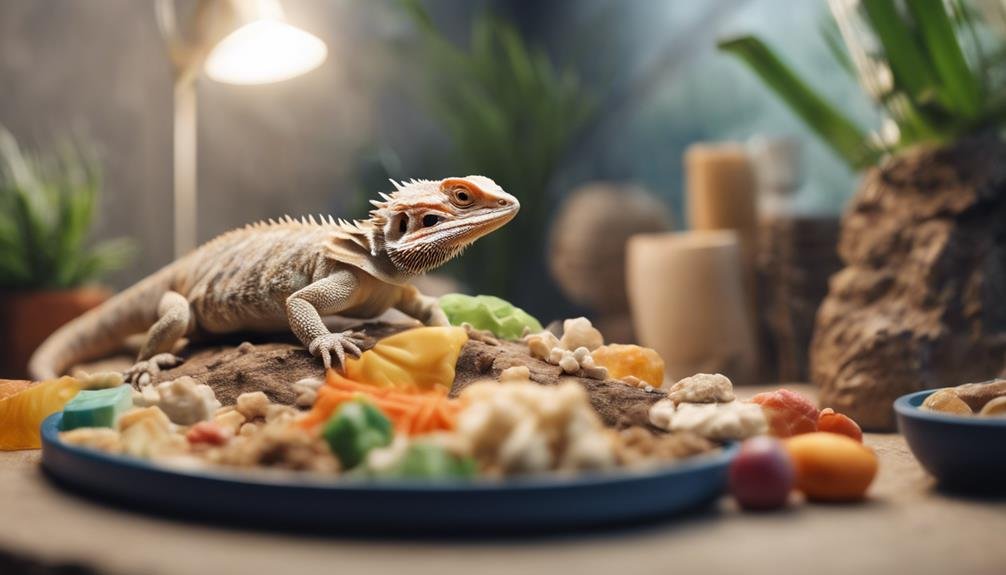

Excessive pooping in bearded dragons often stems from factors like overhydration, dietary choices, parasites, or environmental stress. As bearded dragon owners, it’s important to understand these causes to ensure your dragons stay healthy. Overhydration or consuming too many watery foods, such as cucumbers or watermelons, can increase bowel movements. Additionally, parasites like coccidia can upset your dragon’s digestive system, leading to more frequent pooping.
Environmental stress, such as changes in habitat or temperature fluctuations, can also trigger increased bowel movements. Female dragons may experience excessive pooping during pregnancy due to hormonal changes. Identifying and addressing the root cause is essential for maintaining your bearded dragon’s overall health.
Here’s a quick reference table to help you identify common causes of excessive pooping:
| Cause | Description |
|---|---|
| Overhydration | Consuming too much water or watery foods |
| Dietary Choices | Eating foods that are high in water content |
| Parasites | Presence of coccidia or other internal parasites |
| Environmental Stress | Changes in habitat, temperature, or routine |
| Pregnancy | Hormonal changes in female dragons |
Identifying Healthy Poop
A healthy bearded dragon’s poop should be well-formed with a brown section and distinct white urates. The brown part is the fecal matter, while the white part, known as urates, represents the bearded dragon’s urine.
The urates should be soft but not runny or chalky. By monitoring the poop regularly, you can gauge your bearded dragon’s health and spot any potential issues early on.
Here are some key points to help you identify healthy poop:
- Consistency: It should be firm but not too hard. It might indicate a dietary issue or infection if it’s too soft or runny.
- Color: A healthy poop is typically brown with white urates. Any drastic color changes could signal a problem.
- Odor: While bearded dragon poop isn’t fragrant, an unusually strong or foul smell could indicate an underlying health issue.
- Frequency: Regularity varies with diet and age, but sudden changes in frequency might need attention.
- Shape: It should be well-formed, resembling a log. Misshapen or stringy poop can be a red flag.
White and Brown Poop
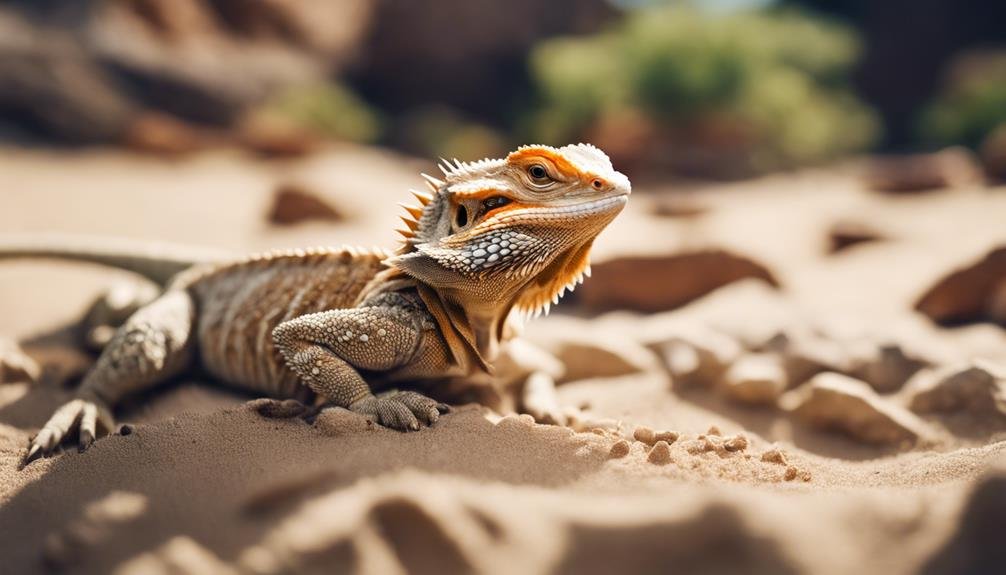

When looking at your bearded dragon’s poop, you’ll see a brown part and a white urate.
The color and consistency of both parts can tell you a lot about your pet’s digestion, hydration, and diet.
Normal Digestion Signs
Normal bearded dragon poop should feature a well-formed brown segment and a distinct white segment called urates. The brown part is typically log-shaped and indicates regular bowel movements, while the white part is a kidney waste product.
When monitoring your bearded dragon poop look, you’ll want to make sure that both segments are present and in good condition.
Here are some key points to keep an eye on:
- Brown Segment: Should be firm and well-formed, resembling a log. This indicates healthy digestion.
- White Segment (Urates): It should be soft but not too hard or chalky, suggesting appropriate hydration and kidney function.
- Frequency: Regular bowel movements, typically once a day or every other day, are a good sign of digestive health.
- Smell: While not pleasant, the smell shouldn’t be overly foul. An extreme odor can be a warning sign.
- Color Consistency: The brown part should maintain a consistent color; any drastic changes might indicate dietary or health issues.
Keeping an eye on these aspects helps you track your bearded dragon’s digestive health effectively. If anything seems off, a visit to the vet might be necessary to guarantee your pet’s well-being.
Hydration and Diet Indicators
They have ever wondered how the color and consistency of your bearded dragon’s poop can reveal significant insights into their hydration and diet? The white and brown components of their poop serve as essential hydration indicators and measures of diet adequacy.
The white part, the urate, indicates your dragon’s hydration level. Healthy bearded dragons produce urate that’s chalky white and soft. If it’s too hard, they might be dehydrated. Conversely, overly runny urate could indicate excessive hydration or kidney issues.
The brown part of your dragon’s poop signifies the digestion of food and the elimination of waste. A well-balanced diet will result in firm, brown stools. If the stool appears overly soft or runny, it might mean their diet isn’t adequate, they are missing essential nutrients, or they are too rich in certain components like fruit.
Monitoring the balance between the white and brown parts of the poop helps you assess both hydration and diet adequacy. Significant changes in the ratio of white to brown can signal problems. Too much white may indicate overhydration, while too little might suggest dehydration.
Similarly, the consistency of the brown part can tell you if their diet needs adjusting. Keep a close eye to make sure your bearded dragon stays healthy.
Abnormal Poop Colors
Identifying abnormal poop colors in your bearded dragon is essential for catching potential health problems early. When you notice unusual hues in their stool, it’s a sign that something might be off with your pet’s health. Abnormal colors indicate various issues, from diet-related problems to more severe health conditions.
- Red Poop: This could be a sign of blood in the stool. It’s important to consult a vet for bloodwork to determine the cause.
- Yellow Poop: Often a signal of dehydration or liver issues. Make sure your dragon is well-hydrated, and consider adjusting their diet.
- Green Poop: Sometimes results from consuming certain greens. If the green color persists, it might indicate a parasitic infection.
- Black Poop: This can be a sign of internal bleeding. Immediate veterinary attention is required.
- Runny Poop: Not a color, but still abnormal. It is often linked to diet changes, stress, or infections. Persistent runny poop warrants a vet visit.
Monitoring your bearded dragon’s poop color can help you detect health issues early. Don’t hesitate to consult a veterinarian for proper diagnosis and treatment if you notice any of these abnormal colors.
Pooping Blood
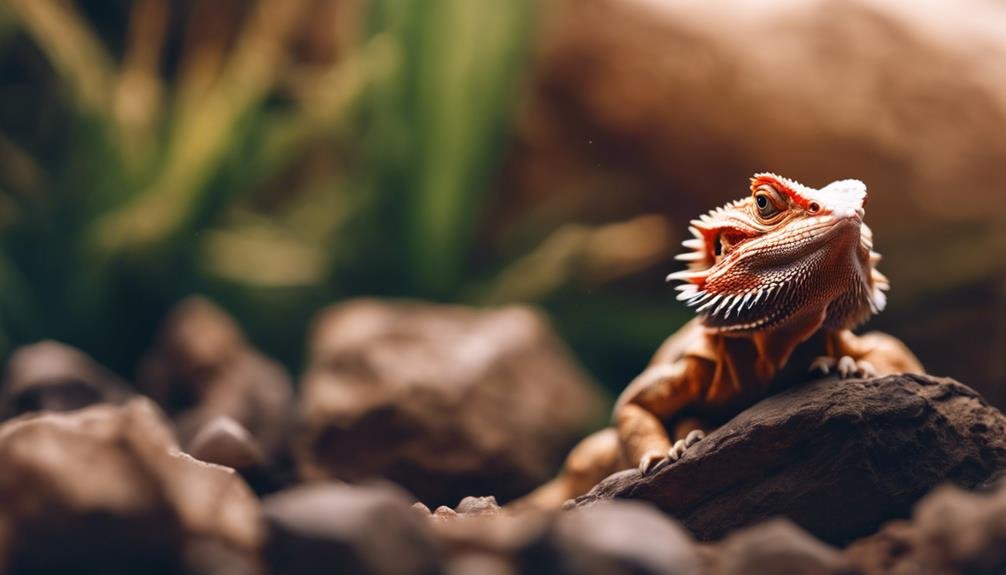

Finding blood in your bearded dragon’s poop can be alarming and often signals constipation or internal bleeding. When you notice blood in poop, it’s important to observe your dragon for additional symptoms.
Constipation is a common issue and can manifest through lethargy, loss of appetite, and weight loss. If your dragon is constipated, try gentle belly massages and make sure they stay hydrated. These measures can often help alleviate the constipation and may resolve the blood in their poop.
However, if the blood persists, it’s time to take action. Persistent blood in poop might indicate a more serious problem like internal bleeding. This could stem from issues such as impaction, parasites, or injuries. Don’t wait for the blood to resolve independently if it continues to appear. Immediate veterinary attention is important to diagnose the underlying cause and provide the necessary treatment.
It’s essential to monitor your dragon closely and act promptly when you see blood in their poop. While sometimes it’s just constipation, persistent blood is a sign that shouldn’t be ignored. Your proactive approach can significantly impact your bearded dragon’s health and well-being.
Encouraging Regular Bowel Movements
A few simple practices can help guarantee your bearded dragon maintains regular bowel movements. First and foremost, a balanced diet rich in fiber, greens, and vegetables is essential. These food items help in promoting healthy digestion and ensuring your dragon poops regularly.
Hydration plays an important role, so always provide a water bowl and mist the enclosure to keep your pet hydrated.
Here are some practical tips to encourage regular bowel movements:
- Balanced Diet: Offer a mix of fiber-rich greens, vegetables, and occasional fruits.
- Hydration: Ensure a steady supply of fresh water and mist the enclosure to maintain humidity.
- Optimal Temperature and Lighting: Keep the habitat at the right temperatures and provide UVB lighting to support digestion.
- Live Insects: Occasionally feed live insects to stimulate natural foraging behavior.
- Warm Baths and Belly Massages: Give your dragon warm water baths and gentle belly massages to relieve constipation.
Cleaning Up Poop
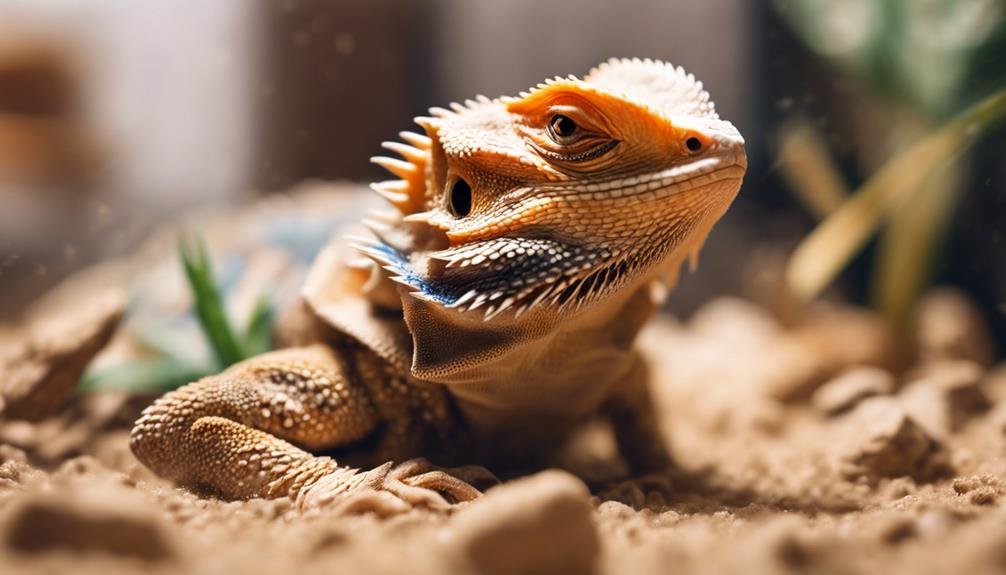

Maintaining a clean environment is as important as ensuring your bearded dragon has regular bowel movements. When it comes to cleaning up poop, using a reptile-safe disinfectant is vital. This guarantees that harmful bacteria don’t build up in your bearded dragon’s habitat, which could potentially harm their health.
Promptly replacing soiled substrates is a key step. Doing so, you maintain a clean and hygienic space for your pet. For those using reptile carpets, spot-treat any poop stains with a pet-safe cleaner. This helps to keep the environment sanitary and free from unpleasant odors.
Avoid loose particle substrates like sand or wood chips. These can make cleaning up poop more challenging and less effective. Instead, opt for substrates that are easier to clean and replace.
Regularly monitoring your bearded dragon’s enclosure allows you to catch and clean up poop promptly, preventing bacteria buildup.
Conclusion
By keeping an eye on your bearded dragon’s poop using the poop chart, you can catch potential health issues early and take action.
Regular monitoring helps guarantee their happiness and health. If you notice any abnormalities, don’t hesitate to adjust your diet or consult a vet.
Remember, a healthy dragon means a happy pet owner, so keep that chart handy and stay proactive in your care.

